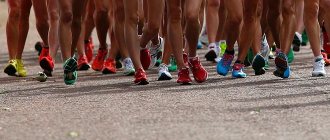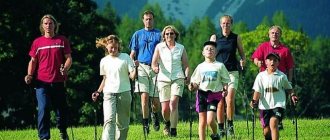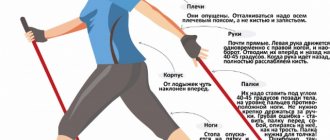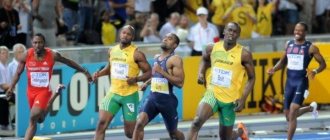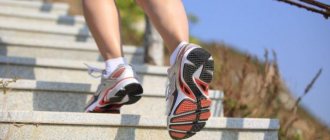Walking can be used to effectively and safely get rid of excess ballast on the body, since not every person can engage in active sports.
When walking, everyone selects the optimal load for themselves, so as not to feel “broken” later. Even with a sedentary lifestyle, a person moves on his feet a distance of 1-10 km per day without noticing it.
If you make walks in a green area the same distance more intense, you can improve your mood, replenish your cells with fresh oxygen, strengthen your heart muscle, blood vessels, improve lung function, and also lose weight by burning calories and develop endurance... while racing walking.
How many calories are burned during different types of walking, you will find the answer to this question in our article.
Race walking
The more meters you walk, the more impressive the amount of calories will be spent.
It is at a speed of 100 steps per minute that will allow you to break down fat in the subcutaneous tissue. You need to start with 10 minutes and gradually increase your daily walk at a sports pace to 40-45 minutes.
Along with calories, you can get rid of extra centimeters on your waist and hips and in return get health, lightness and moral satisfaction.
You need to walk in a straight line, using small and frequent steps with your elbows bent and your buttocks tense.
How many calories do we burn during normal walking?
when walking quickly, you can burn about 200-300 kcal in an hour.
If the walk takes place in an urban area on pavement or asphalt, then fewer calories are consumed than in a park area with hills and depressions. On average, you can get rid of 200-300 kcal per hour when using a fast pace.
With a weight of 60 kg and a speed of 4 km/h, you can lose an average of 250 kcal, and at a speed of 6 km/h - 320 kcal.
- at a speed of 4 km/h on a flat road per 1 kg of weight in 1 hour - 3.2;
- at a speed of 6 km/h on a flat road - 4.5;
- at a speed of 8 km/h on a flat road - 10;
- at a speed of 2 km/h uphill - 6.4;
- during a regular walk in the park - 6.4;
- during race walking - 6.8 kcal.
- 3 km/h is 50 steps;
- 4.5 km/h is 75 steps;
- 6 km/h is approximately 100 steps.
Skiing
while skiing, not only the arms and legs actively work, but also all the organs and muscles of the body.
If a person prefers skiing in winter, it helps strengthen the blood vessels and heart, lungs and spine, vestibular apparatus and nervous system and improves metabolic processes in the body.
Excess weight is one of the most pressing problems that worries modern society. They are trying to solve it in different ways. Some people go on a diet, others take special medications to lose weight. There are also those who purchase products that promote weight loss, and others start going to the gym. However, the most effective measures for losing weight are considered moderate physical activity and proper nutrition. Only this will help you get rid of extra pounds without harm to the body. Please note that even regular walking is considered moderate physical activity. However, to increase the effectiveness of this exercise, you need to know a few rules. Today we will find out how many calories are burned when walking in 1 hour and how we can improve this result.
How long is it recommended to walk each day?
Everyone has probably heard about 10 thousand steps a day to get rid of all diseases and problems? As in the case of 2 liters of water, this is a stereotype. And it comes from Japan, where the inventor of the first electronic pedometer, Yoshiro Hatano, called it Mampo-kei. Translated into Russian, this means “10,000 steps.” One version of why Yoshiro named his invention this way is that it’s just a beautiful round number.
10,000 steps is approximately 8 km. And many, of course, are frightened by this figure. There is no need to take it literally, because there are a lot of variables: what surface a person moves on, at what speed, in what weather conditions and, finally, what kind of training a person has. Even going up from the 1st floor to the 18th-20th floor a couple of times carries a load that is much greater than idle wandering throughout the day.
A simple rule: less is better, but more is more active. Research from the Active 10 Project shows that 3 brisk, 10-minute walks a day are healthier than 10,000 slow steps. In addition, short but fast walks are better suited for the modern rhythm of life.
The recommended rate of physical activity for a person is at least 150 minutes per week. Such recommendations are given by the World Health Organization. Walking or other activity should be done at least 30 minutes a day, 5 times a week. And this is just to maintain health. Note that physical activity can be distributed throughout the day:
- 10 minutes of brisk walking three times a day;
- or 20 minutes in the morning and 10 minutes later during the day.
Doctors advise counting not the steps taken, but the total time of physical activity, but if you are still interested in the numbers of steps taken, there are now many fitness bracelets on the market with a step counting function. The same mobile applications can be installed on any smartphone.
How many calories can you burn by walking for an hour?
You should know that this indicator will be individual for each person. It all depends on weight, age, health, metabolism, etc. We will only give the average value as a guide.
Please note that the data you will see below is calculated for 1 kg of weight, that is, you can calculate the indicator for yourself as follows. Take the number of kilocalories and multiply them by your weight. The result obtained will be your indicator.
- Walking on asphalt or a flat road at a speed of 4 km/h - 3.2 kcal per 1 kg of weight.
- Walking on asphalt or a flat road at a speed of 6 km/h - 4.5 kcal per 1 kg of weight.
- Walking on asphalt or a flat road at a speed of 8 km/h - 10 kcal per 1 kg of weight.
- Climbing uphill at a speed of 2 km/h - 6.4 kcal per 1 kg of weight.
- Hiking in nature (for example, in the forest or on the beach) - 6.4 kcal per 1 kg of weight.
- Race walking - 6.8 kcal per 1 kg of weight.
To avoid buying devices to determine your own speed, you just need to count your steps while walking.
If you take 50 steps per minute, the walking speed will be 3 km/h, 75 steps per minute will be a speed of 4.5 km/h, 100 steps per minute will be a speed of 6 km/h. Burning calories while walking:
an effective way to improve your health and safely lose weight
Tempo, what is it?
There is such a thing as running pace. It indicates how long it takes a person to cover a certain distance. This indicator is convenient to use when training, choosing how long it takes to cover a given distance in order to achieve the desired effect: lose weight, improve endurance, train the heart, etc. For example, the pace for training the heart muscle and fat oxidation can vary among people of different sizes and fitness from 5:30 to 7:00 minutes/km. For cross-country, a pace of around 5:00 min/km is suitable. But all indicators are individual, since people are all different.
Types of walking for weight loss
To quickly achieve weight loss, it is recommended to engage in race walking. It will help you quickly get rid of extra pounds. The essence of it is to take small steps, placing your feet in a straight line. Your arms should be bent at the elbows. Such walking not only helps you lose weight, but also makes your legs slender, your stomach flat, and your buttocks toned. If you pick up dumbbells that weigh less than a kilogram, you will achieve the result much faster. In this case, you can perform the following exercises. When extending your right leg, your left arm should be placed in front of you, without bending it at the elbow. The same must be done in the other direction. This exercise is only performed halfway, and the second half should be performed with a simple athletic step.
In addition to race walking, other types of movement are also effective in losing weight.
- Walking in reverse. In this case we are talking about walking backwards. It will help tighten your buttocks and flatten your stomach. The movement should start slowly, gradually increasing the pace. It's best to have someone nearby to help you avoid tripping.
- Climbing up. If you do not move on a flat surface, but start going uphill or up steps, you will achieve results much faster.
- Walking with tense buttocks and a straight back will increase efficiency and calories will be burned much faster.
- Nordic walking with poles. This type of exercise is suitable even for older people. This walking increases calorie burning by 45%. It guarantees weight loss of an average of 3 kg per week.
Warm-up
Regardless of the purpose of race walking - whether it is for health improvement or to prepare for a competition - it is extremely important to choose the right shoes and warm up thoroughly before training.
The warm-up begins with stretching the calf muscles. The following exercise will help with this: we rest our hands on the wall, move one leg back, while doing light squats on the other leg. The duration of the exercise is about 7 minutes.
Next, you need to stretch the back of your thigh: stretch one leg forward and place it on a chair. Now you need to tilt your torso towards this leg. To stretch the front of the thigh, you need to stand on one leg and pull the other leg towards your buttocks with your hands.
To stretch your hips, you need to perform several alternating lunges with your torso forward and backward, while your leg should stand on a chair with your knee bent. The total duration of the warm-up is at least 20 minutes. This preparation will allow you to stretch and warm up your muscles well and avoid injury.
Walking Rules for Burning Calories
It’s not enough to know how many calories are burned when walking in 1 hour; you also need to do the workout correctly to achieve maximum results.
- The training time should be at least half an hour. Only such walking will have an effect on weight loss.
- You don’t need to start training right away, choosing the maximum amount of time for this, otherwise your muscles will not withstand the load and will be very sore. The first sports walk should be 10 minutes, the second 15, etc., bringing it to the desired time.
- For training, you need to choose comfortable shoes and clothes that will not restrict your movements while walking.
- The foot should be placed from heel to toe.
- The walk should be taken away from the roadway.
- If you get tired and feel pain in your muscles, you need to take a break and then continue exercising.
- Do your workouts every day, otherwise they will be of no use.
Knowing how many calories are burned when walking in 1 hour, you can choose the optimal training time and load for yourself. Then with the help of this exercise you can easily and quickly get rid of excess weight.
Hello my dear readers! Many people don't have enough time for sports. And not everyone is physically capable of jogging on the street or lifting weights in the gym. But if you lead a sedentary lifestyle, the extra pounds will not leave you alone. Just don't despair. Better take up walking! How many calories are lost when walking? Let me tell you.
It turns out that walking is a wonderful sport. Yes, yes, walking is a sport. The benefits from it are special. After all, it trains all the same muscles as running. At the same time, it does not have a negative effect on the knee joints. Plus it improves heart function and saturates our cells with oxygen. Everyone can walk: fat and thin, old and young.
Many people care about the topic of weight loss. It is very difficult to fight the hated kilograms while sitting. Forcing yourself to play sports is even more difficult. But going for a walk in the evening after work is as easy as shelling pears!
Of course, to lose weight it’s not enough to go shopping. How many calories are burned per hour of walking depends on:
- presence/absence of additional equipment (walking poles, weights);
- your weight;
- your age;
- level of physical fitness;
- pace;
- duration;
- roads (it’s harder to walk uphill);
- intensity of hand movement.
It is clear that if you walk quickly, you will burn more calories than if you walk at a slow pace. Plus, it is better to conduct classes in a park or forest. The load will immediately increase due to unevenness on the road.
In 1 hour of walking you can burn 200 kilocalories or more. You can independently calculate how many calories your body will burn.
For one kilogram of weight, each person spends an hour walking:
- at an average pace (4 km/h) 3.2 kcal;
- at a fast pace (6 km/h) 4.5 kcal;
- almost running (8 km/h) 10 kcal;
There is also a convenient sign where you can see how much you will spend depending on your body weight and walking speed.
| Speed/Body Weight | 50 kg | 55 kg | 60 kg | 65 kg | 70 kg | 75 kg | 80 kg | 85 kg | 90 kg |
| 3 km/h | 126 | 138 | 150 | 163 | 175 | 187 | 201 | 213 | 226 |
| 4 km/h | 160 | 177 | 192 | 209 | 224 | 240 | 257 | 272 | 288 |
| 5 km/h | 184 | 202 | 221 | 239 | 258 | 276 | 295 | 312 | 331 |
| 6 km/h | 217 | 238 | 262 | 283 | 304 | 326 | 349 | 369 | 392 |
| 7 km/h | 291 | 321 | 351 | 379 | 409 | 439 | 467 | 496 | 526 |
| 8 km/h | 374 | 410 | 449 | 487 | 523 | 562 | 598 | 636 | 673 |
| 9 km/h | 480 | 530 | 577 | 625 | 674 | 722 | 769 | 818 | 866 |
That is, if you weigh 55 kg and walk at an average speed, you will lose 202 kcal in an hour.
Considering all this is completely inconvenient. After all, you still need to correctly estimate the speed. If you know exactly the distance traveled, calculating the speed is easy. And if not? Count steps per minute? This will make you more tired than walking itself!
I recommend using a fitness bracelet. You put it on your hand, and he counts how much time has passed. For me, this is a convenient and simple electronic pedometer.
Although there are, of course, many applications on a smartphone - download it for free, install it and use it. They write that it counts the distance traveled, speed and number of calories lost. But is it really that convenient? No matter how many programs I tried, they produced a huge error. I walk 10 steps, and he counts 7 or doesn’t even understand that I’m walking. So you have a choice - toil with a free program, or purchase a specialized device.
Bibliography
- Bondin V.I. Kinesis-energonomic foundations for constructing physical education and health programs // Tauride Scientific Observer. – 2022. – No. 12. – Part 2. – P.28–33.
- Gortsev G. How to become slim. Secrets of losing weight. – M.: T8 RUGRAM, 2022.
- Kulakov V. N., Popov Yu. A., Tikhonov S. A., Suslov F. P. Middle and long distance running / ed. ed. V. V. Kuznetsova. – M.: Physical culture and sport, 1982. – 174 p.
- Pyastolova N. B., Gurov A. I., Taratynova O. V. Methodological foundations of independent physical exercises // Physical culture. Sport. Tourism. Motor recreation. – 2016. – T.1. - No. 3. – P.44–47.
- Tudor-Locke C., Pangrazi RP, Hatano Y., Kang M.. Revisiting “How Many Steps Are Enough?” // Medicine & Science in Sports & Exercise. – 2008. – No. 40 (7). – pp. 537–543.
- I-Min Lee, Eric J. Shiroma, Masamitsu Kamada, et al. // JAMA Intern Med. Published online. – 2022. – No. 179 (8). – P. 1105–1112.
Author: Chernetsov M. A.
Reviewer: reflexologist Kurus A. N.
How to walk correctly
You don’t need to immediately start walking quickly for 3 hours a day. Especially if you are no longer 20 years old and do not weigh 50 kg. Start with hour-long walks at a slow pace. Then increase the pace for 5 minutes, then for 10 minutes and so on. Gradually you will begin to walk for 1 hour at an average pace. Want to spend more energy? Then increase the pace again and add time.
The main rule is to walk for at least an hour. When walking, fat begins to be burned no earlier than forty minutes later. Our body is extremely thrifty and first spends available carbohydrates.
Also remember not to exercise immediately after eating. The optimal time for training is an hour after eating. And when you finish your classes, don't rush to eat. Drink a glass of water. You can afford an apple or.
While walking, remember to breathe. Inhale through the nose, exhale through the mouth. It is also important to quit smoking. It negatively affects breathing and the cardiovascular system. Shortness of breath and even dizziness will appear.
Give yourself a nice gift. Buy nice sportswear and comfortable sneakers. Better yet, buy special clothes that help burn fat. For example, . They create a sauna effect and help you lose weight much faster.
What are the benefits of walking?
Many are accustomed to thinking that if you get cardio exercise, it must be through running, cycling or skiing. However, walking, just like the exercises listed, strengthens the cardiovascular system, being the most non-traumatic type of activity.
Here are just some of the most noticeable benefits that walking gives your body:
- helps you lose weight or maintain a healthy weight;
- long and fast walks increase endurance;
- helps prevent or manage chronic diseases;
- for people leading a sedentary lifestyle, 20 minutes of walking a day reduces the risk of premature death by 16-30% (American Journal of Clinical Nutrition study);
- for older people, an hour's walk 3 times a week reduces the risk of dementia;
- walking strengthens the heart;
- relieves stress, reduces anxiety;
- Walking as a means of cross-training allows your joints and muscles that are actively involved in running to rest;
- On a rest day from training, walking is an effective way to burn fat and increase blood flow for muscle recovery.
How to increase your calorie expenditure
There are several ways to increase the load. Race walking will make you sweat. But this is a super-effective way to get rid of extra centimeters. The tummy will be flat, and the buttocks will be a sight to behold.
Swing your arms
To work your upper body, swing your arms. This will increase the load and walking speed.
Bend your elbows at an angle of 90° and make amplitude swings of your arms back and forth.
Add weight
Is it easy for you to walk and don’t you get tired? Try adding weight. This will increase the intensity and challenge your muscles. Avoid wearing weights on your wrists and feet. They can change your gait and posture and increase your risk of injury.
Instead, grab a backpack or weighted vest. If you decide to wear a backpack, fill it with water, sand, or simple cat litter. This will distribute the weight evenly.
If the weather does not allow you to go outside, take the stairs or stay indoors. Do a short warm-up first. How many calories are spent during these types of training, read the article “training options for losing weight.”
Walking with poles
It is one of the best ways to increase the number of calories burned. It is suitable for all ages and skill levels. The result is incredible. Nordic walking uses 90% of the muscles in our body and increases calorie consumption by up to 46% compared to normal walking. Poles help reduce stress on the ankle, knee and hip joints.
I recently purchased some poles myself. I noticed that the load on my legs doubled and the muscles of my arms and upper back became involved.
We walk on a treadmill
If it is not possible to walk on the street, then... On average, a person walks at a speed of 4-5 km per hour. To lose weight and get in good physical shape, you need to increase your pace and walk from 5.5 to 6.5 km per hour. By increasing the pace, you burn about a third more calories. It’s just not worth increasing it any further, because... It will no longer be walking but running. And this is another story, which I wrote about in the article.


